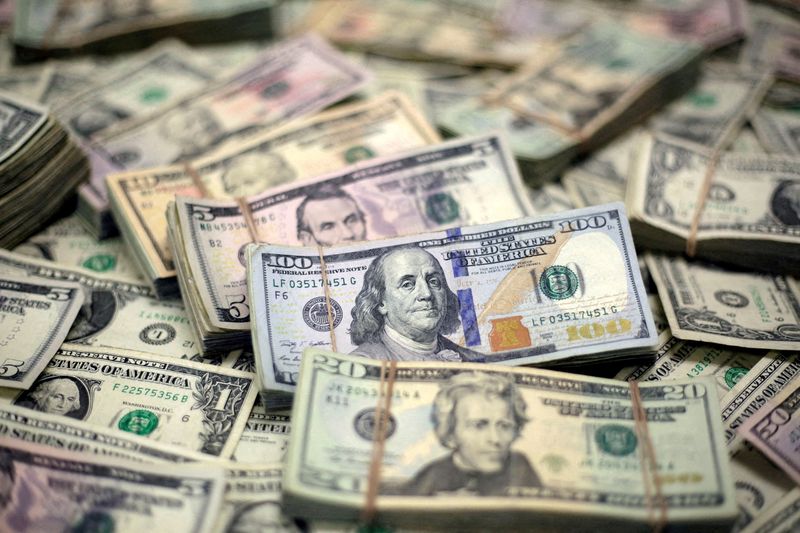
By Ankur Banerjee
SINGAPORE (Reuters) -The dollar clung to seven-week highs against major currencies on Tuesday as investors pondered the outlook for U.S. rates after a strong jobs report last week dashed bets for large rate cuts, while escalating tensions in Middle East dented risk sentiment.
Traders have drastically shifted their monetary easing expectations from the Federal Reserve this year.
Markets are no longer fully pricing in a rate cut in November and are ascribing an 86% chance of a 25 basis points reduction, the CME FedWatch tool showed. Just 50 bps of easing is priced in by December, down from more than 70 bps a week earlier.
That has kept the dollar on the front foot and surging to a multi-week high against the euro, sterling and the yen, though the yen clawed back some of the losses on Tuesday as rising geopolitical worries led to safe-haven flows.
The dollar index, which measures the U.S. currency against major rivals, last fetched 102.38, just below the seven-week high of 102.69 it touched on Friday.
A shallower path of cuts from the Fed, coupled with strong data and the prospect of a “no landing” scenario where the labour market continues to burn hot even as inflation cools has helped support the dollar, said Kieran Williams, head of Asia FX at InTouch Capital Markets.
“While the USD has room to strengthen from here, given the hawkish repricing post-FOMC other catalysts may be necessary.”
Federal Reserve Bank of St. Louis President Alberto Musalem said on Monday he supports more rate cuts as the economy moves forward on a healthy path, while noting that it is appropriate for the Fed to be cautious and not overdo the monetary easing.
The benchmark 10-year U.S. Treasury yield remained above 4% in Asian hours, having touched the level on Monday for the first time in two months as traders curtailed wagers on super-sized rate cuts. [US/]
Investor focus this week will be on the inflation report due on Thursday as well as the minutes of the Fed’s September meeting scheduled to be released on Wednesday.
“We don’t see conditions in place for a recession, and believe the economy is in relatively good shape despite the current slowdown,” said Steve Boothe, a portfolio manager in the fixed income division at T. Rowe Price.
“We expect the Fed to deliver 2 more 25 bps rate cuts this year, for a total of 6 cuts by next year.”
Meanwhile, China equity markets returned with a strong open after a week-long holiday break, but capped some gains as optimism around stimulus measures wavered a bit on lack of details.
The yuan eased a bit on dollar strength, with the onshore yuan weakening to 7.0635 per dollar.
Elsewhere, the euro fetched $1.09865, not far from the seven-week low of $1.09515 it hit last week. The pound was at $1.3094, close to the more than three-week low of $1.30595 it touched on Monday.
The yen was last a tad stronger at 148.07 per dollar, having slumped to a seven week low of 149.10 on Monday as traders contemplated the interest rate path that the Bank of Japan is likely to take in the near term.
New Japanese Prime Minister Shigeru Ishiba stunned markets last week when he said the economy was not ready for further rate hikes, an apparent about-face from his previous support for the BOJ unwinding decades of extreme monetary stimulus.
Those comments pushed the yen lower and cast doubts over how aggressive the BOJ would be in raising rates.

In other currencies, the Australian dollar slid to its lowest since Sept. 16 of $0.6715 after the minutes from the latest meeting of the nation’s central bank sounded slightly dovish and the Chinese stocks rally lost momentum. The Aussie was last down 0.24% at $0.6742.
The New Zealand dollar was flat at $0.6127 ahead of the monetary policy decision on Wednesday. A majority of economists in a Reuters poll last week forecast the Reserve Bank of New Zealand will cut interest rate by 50 basis points. [AUD/]
This post is originally published on INVESTING.



